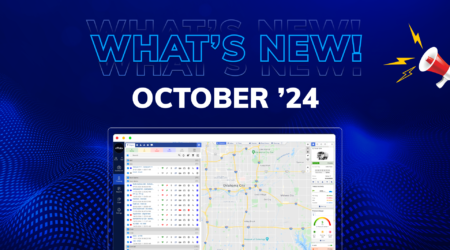The Power of Fleet Mobility
Fleet mobility, a critical component of the modern logistics and transportation sector, encompasses the strategies and technologies employed to maximize the efficiency, safety, and reliability of vehicle fleets. At its core, fleet mobility aims to ensure seamless, uninterrupted movement of goods and services, catering to the ever-growing demands of global commerce. Integral to this endeavor is advanced fleet management software, which offers sophisticated tools for real-time tracking, route optimization, vehicle maintenance, and driver management. These technologies not only streamline operations but also significantly reduce costs and enhance service delivery, marking a pivotal shift in how fleets are managed and operated.
What is Fleet Mobility?
Fleet mobility refers to the integrated management and coordination of a company’s vehicle fleet in a way that ensures efficient, safe, and reliable transportation of goods, services, or personnel. It encompasses a wide range of activities including vehicle tracking, route optimization, fuel management, maintenance scheduling, driver management, and compliance with safety and regulatory standards. The aim of fleet mobility is to improve the operational efficiency of the fleet, reduce costs, enhance safety, and ensure that vehicles are available when and where they are needed.
With the advent of advanced fleet management software, fleet mobility has transformed significantly. These sophisticated tools offer real-time data and analytics, GPS tracking, and automated processes for managing every aspect of the fleet’s operations. This enables businesses to make informed decisions quickly, optimize routes to reduce fuel consumption and travel times, schedule preventive maintenance to avoid breakdowns, and ensure drivers adhere to safety and regulatory requirements.
In essence, fleet mobility is a critical component of modern logistics and transportation systems, allowing companies to navigate the complexities of managing a fleet of vehicles efficiently and effectively. It leverages technology to streamline operations, improve service delivery, and achieve sustainability goals by minimizing environmental impacts through optimized route planning and vehicle maintenance.
The Evolution of Fleet Mobility
The journey from traditional, paper-based fleet management to today’s digital, connected fleet mobility solutions mirrors the broader technological advancements in society. Initially, fleet management was heavily reliant on manual record-keeping and physical communication methods. However, the advent of GPS technology and the internet ushered in a new era of digital fleet management. This section will trace the technological evolution that has culminated in the sophisticated fleet mobility systems in use today, highlighting key milestones and the impact of digital transformation on the logistics and transportation industry.
The Role of Advanced Fleet Management Software in Fleet Mobility
The role of advanced fleet management software in fleet mobility is pivotal, transforming how businesses manage and operate their vehicle fleets. This software brings together a suite of technologies and tools designed to optimize fleet performance, enhance safety, reduce operational costs, and improve customer satisfaction. Here’s a deeper look into the various aspects of advanced fleet management software and its impact on fleet mobility:
Real-time Tracking and Monitoring
- GPS Tracking: Advanced fleet management systems utilize GPS technology to provide real-time location tracking of each vehicle in the fleet. This capability is fundamental for route optimization, ensuring timely deliveries, and enhancing the security of vehicles and cargo.
- Telematics: Telematics technology goes beyond simple GPS tracking, offering insights into vehicle health, driver behavior, and fuel consumption. It enables fleet managers to monitor a wide range of data points, including speed, idling time, harsh braking, and more, which can be used to enhance operational efficiency and driver safety.
Route Optimization
- Dynamic Routing: Advanced software analyzes various factors such as traffic conditions, weather, vehicle type, and cargo requirements to determine the most efficient routes. This reduces fuel consumption, saves time, and increases the number of deliveries or service calls that can be made in a day.
- Scheduling and Dispatch: The software allows for effective scheduling and dispatching of vehicles, ensuring that the right vehicle is sent on the most appropriate route, further optimizing fleet operations.
Maintenance and Compliance
- Predictive Maintenance: By monitoring vehicle diagnostics, the software can predict maintenance needs before they become serious issues, reducing downtime and repair costs. Scheduled maintenance reminders help keep vehicles in optimal condition, extending their lifespan.
- Regulatory Compliance: Fleet management software helps businesses comply with regulatory requirements, such as Hours of Service (HOS) and Electronic Logging Devices (ELD) mandates, by automating record-keeping and reporting processes.
Data Analytics and Reporting
- Insights and Performance Metrics: The software provides detailed analytics and reports on fleet performance. It offers insights into areas such as fuel efficiency, driver performance, and cost savings. This data is invaluable for making informed decisions and identifying opportunities for improvement.
- Customizable Dashboards: Many advanced fleet management systems feature customizable dashboards. It gives managers a quick overview of their fleet’s status. This includes real-time alerts for any issues that need immediate attention.
Enhancing Safety and Security
- Driver Safety Programs: The software is used to develop and enforce driver safety programs. This reduces the risk of accidents. Features such as driver scoring and feedback loops encourage safe driving behaviors.
- Vehicle Security: Real-time tracking and geofencing capabilities enhance the security of vehicles and cargo by alerting managers to unauthorized use or deviations from planned routes.
Customer Satisfaction
- Improved Service Delivery: With optimized routes and schedules, fleets can achieve more timely and reliable service delivery. Real-time tracking allows for accurate ETA predictions, enhancing communication with customers and improving their overall satisfaction.
Integration and Scalability
- Integration with Other Systems: The software often integrates with other business systems, such as inventory management and customer relationship management (CRM) software. It creates a seamless flow of information across business functions.
- Scalability: The software easily accommodates new vehicles and drivers, and ensuring the software continues to meet the needs of a dynamic fleet.
Benefits of Enhanced Fleet Mobility
Enhanced fleet mobility, offers a myriad of benefits that not only streamline operations but also contribute significantly to businesses managing fleets.
Streamlined Operations:
Enhanced fleet mobility optimizes routes and schedules, reducing travel times and enabling more deliveries or service calls within the same timeframe. This efficiency boost directly impacts productivity and operational capacity.
Reduced Downtime:
Predictive maintenance, facilitated by advanced fleet management software, minimizes unexpected breakdowns and keeps vehicles running smoothly, significantly reducing downtime and associated costs.
Fuel Savings:
Optimized routing and improved driver behaviors, such as reduced idling and adherence to speed limits, lead to significant fuel savings. Advanced systems can identify the most fuel-efficient routes, further reducing fuel consumption.
Maintenance Costs:
Regular maintenance alerts and predictive maintenance capabilities help avoid costly repairs and extend vehicle life, saving on long-term maintenance expenses.
Driver Safety:
Real-time monitoring and analysis of driver behavior promote safer driving practices. Systems can alert fleet managers to risky behaviors, allowing for immediate corrective actions and the development of targeted safety programs.
Reliable Service Delivery:
With enhanced fleet mobility, businesses can provide more accurate delivery times and faster service, improving overall customer satisfaction. Real-time tracking allows customers to receive updates on their service or delivery, setting realistic expectations.
Quality Service:
The efficiency and reliability gained from enhanced fleet mobility translate into higher quality service, fostering customer loyalty and positive brand perception.
Insightful Analytics:
Advanced fleet management systems offer comprehensive analytics and reporting tools that provide valuable insights into fleet operations. Businesses can use this data to make informed decisions, identify inefficiencies, and uncover opportunities for improvement.
Performance Benchmarking:
Detailed reports on vehicle and driver performance enable benchmarking against industry standards or internal goals. It helps businesses strive for continuous improvement.
Reduced Carbon Footprint:
Efficient routing and reduced fuel consumption contribute to lower greenhouse gas emissions. It supports businesses efforts to operate more sustainably and reduce their environmental impact.
Eco-friendly Practices:
Enhanced fleet mobility encourages eco-friendly practices, such as optimizing load capacities and reducing unnecessary trips, which further supports sustainability goals.
Adaptable to Business Growth:
Fleet management solutions designed with scalability in mind can easily adapt to growing business needs. They can accommodate new vehicles and drivers without compromising performance.
Flexible Integration:
The ability to integrate with other business systems allows for a seamless flow of information and enhances operational flexibility.
The Future of Fleet Mobility
Conclusion
Fleet mobility, enhanced by advanced fleet management software, is a cornerstone of efficient, cost-effective, and customer-focused logistics and transportation operations. As industries evolve, integrating these technologies becomes crucial for companies. It helps enhance fleet operations and navigate the challenges of today’s marketplace effectively.





